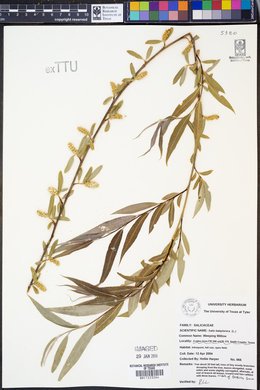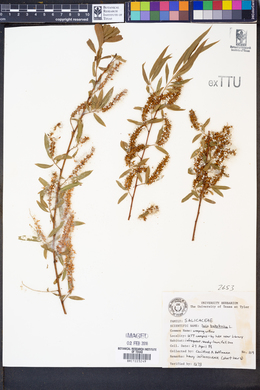|
|
|
|
Family: Salicaceae
weeping willow, more...weeping willow, Wisconsin weeping willow
[Salix X pendulina Wenderoth, moreSalix X sepulcralis Simonkai] |
PLANTS: Tree to 20 m tall. STEMS: pendulous almost to the ground; branches highly brittle at base, yellow- to gray-brown, becoming glabrous; branchlets yellowish or yellow-brown, villous, especially at the nodes, becoming glabrous. LEAVES: petioles tomentose, 7-12 mm long, sometimes gland-dotted at base of blade; proximal leaves of vegetative branchlets or leaves on flowering branchlets entire or gland-dotted; young leaves glabrous or sparsely silky; mature blade ligulate, very narrowly elliptic or narrowly lanceolate, 70-140 mm long, 9-18 mm wide, 6.5-13 times as long as wide, the lower surface glaucous, short silky becoming glabrous, the upper surface dull, glabrous or short silky becoming glabrous, the base cuneate, the margins flat, serrulate to spinulose-serrulate, with 4-10 teeth per em, the apex acuminate. INFLORESCENCE: coetaneous, floral bracts tawny, 1.2-2 mm long, wavy hairy, the apices acute to rounded. STAMINATE FLOWERS: in densely flowered catkins 25-35 mm long; flowering branchlets to 3 mm long; filaments hairy; nectaries 1 abaxial, l-several adaxial, broad to ovate, 0.5-0.64 mm long. PISTILLATE FLOWERS: in densely flowered catkins 18-22 mm long; flowering branchlets 4-10 mm long; ovaries glabrous; stigmas 0.16-0.36 mm long; styles 0.15-0.2 mm long; stipes 0-0.3 mm long; nectaries broad, 0.5-0.7 mm long, longer than stipe. 2n = 76. NOTES: Gardens or disturbed areas mostly near settlements; Coconino, Maricopa, Navajo cos.; Mar-Apr; throughout warmer parts of N. Amer from CA to se U.S.; cultivated, sometimes naturalized; native of Asia. Hybridizes with S. alba. Figure 4. REFERENCES: Argus, George W. 1995. SalicaceaePart 2. Salix. J. Ariz. – Nev. Acad. Sci. 29(1): 39 Stems: branches yellow-brown to red-brown; branchlets sparsely to moderately densely tomentose, especially at nodes. Leaves: stipules absent or rudimentary on early ones; petiole convex to flat or shallowly to deeply grooved adaxially, 7-9 mm, tomentose abaxially; largest medial blade lanceolate, narrowly oblong, or narrowly elliptic, 90-160 × 5-20 mm, 5.5-10.5 times as long as wide, base cuneate, margins flat, spinulose-serrulate or serrulate, apex acuminate, caudate, or acute, surfaces glabrous or sparsely short-silky, hairs straight, dull adaxially; proximal blade margins entire; juvenile blade reddish or yellowish green. Catkins (flowering just before leaves emerge); staminate 13-35 mm, flowering branchlet 1-6 mm; pistillate densely flowered, stout or subglobose, 9-27 × 2.5-7 mm, flowering branchlet (0-)2-4 mm; floral bract 1.1-1.8 mm, apex acute, rounded, or truncate, entire, abaxially sparsely hairy throughout or proximally, hairs wavy. Staminate flowers: abaxial nectary 0.2-0.6 mm, adaxial nectary oblong or ovate, 0.4-0.7 mm, nectaries distinct or connate and cup-shaped; filaments distinct, hairy on proximal 1/2 or basally; anthers (sometimes reddish turning yellow), ellipsoid or globose. Pistillate flowers: adaxial nectary oblong, square, ovate, or obovate, 0.4-0.8 mm; ovary ovoid or obturbinate, beak (sometimes pilose proximally), slightly bulged below or abruptly tapering to styles; ovules 2-4 per ovary; styles distinct or connate 1/2 their lengths, 0.2-0.3 mm; stigmas flat, abaxially non-papillate with rounded tip, or 2 plump lobes (almost capitate), 0.2-0.3 mm. Capsules 2-2.7 mm. 2n = 76. Flowering spring. Around settlements; ca. 50 m; introduced; Ala., Ark., Calif., Del., D.C., Fla., Ga., Ky., La., Md., N.C., S.C., Tenn., Va.; Asia; introduced also in Mexico (Mexico City), South America. Little is known about the origin of the strongly weeping cultivar of Salix babylonica. It was described by Linnaeus (1737[1738]) based on young garden specimens (W. J. Bean 1970-1988, vol. 4). It is thought to have originated in China, although it no longer occurs in the wild and its origin is uncertain. Selections are thought to have been transported to Europe along the trade route from China. In Tajikistan, there are three cultivated clones, one of which is staminate (A. K. Skvortsov 1999). Taxonomic treatments of S. babylonica are variable. Some botanists recognize a single species, including both pendulous and non-pendulous forms (Skvortsov), while others recognize four species: S. babylonica, with a weeping habit, S. capitata Y. L. Chou & Skvortsov, S. pseudolasiogyne H. Léveillé, and the commonly cultivated S. matsudana Koidzumi (Fang Z. F. et al. 1999), with an erect or spreading habit. Here, S. babylonica is treated in a narrow sense, including only weeping forms. Salix babylonica is not cold tolerant and is not commonly grown in Europe (R. D. Meikle 1984) or in northern North America. In the flora area, cultivated trees with strongly pendulous branches and branchlets have been identified as S. babylonica (G. W. Argus 1985, 1986, 1993), but many are hybrids with S. alba (S. ×sepulcralis) or S. euxina (S. ×pendulina). Salix ×sepulcralis, especially nothovar. chrysocoma, with bright yellow branchlets, is the most commonly grown of these hybrids. All reported occurrences of S. babylonica need verification. Hybrids: Salix ×sepulcralis Simonkai: Weeping willow, S. alba × S. babylonica, is introduced from Europe and widely naturalized throughout the world. Synonyms include S. ×salamonii Carrière ex Henry and S. ×sepulcralis nothovar. chrysocoma (Dode) Meikle. It is characterized by: trees, to 12 m, stems pendulous; branches somewhat to highly brittle at base, yellowish, yellow-green, or yellow-brown; branchlets yellowish, yellow-green, or golden; stipules rudimentary or foliaceous on late leaves; petiole not glandular or with pairs or clusters of spherical glands distally or scattered throughout, short-silky adaxially; largest medial blade amphistomatous or hemiamphistomatous, narrowly elliptic to very narrowly so, margins finely serrulate or spin |






















